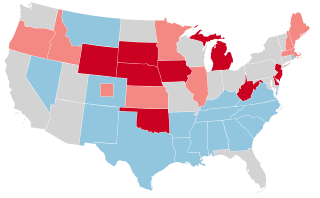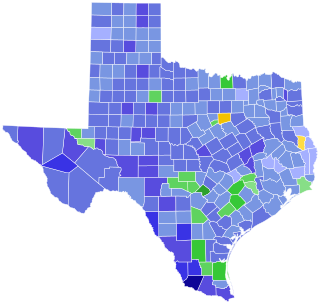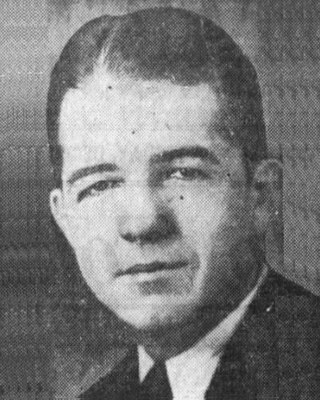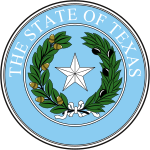
Ralph Webster Yarborough was an American politician and lawyer. He was a Texas Democratic politician who served in the United States Senate from 1957 to 1971 and was a leader of the progressive wing of his party. Along with Senate Majority Leader Lyndon B. Johnson and Speaker of the House Sam Rayburn, but unlike most Southern congressmen, Yarborough refused to support the 1956 Southern Manifesto, which called for resistance to the racial integration of schools and other public places. Yarborough voted in favor of the Civil Rights Acts of 1957, 1960, 1964, and 1968, as well as the 24th Amendment to the U.S. Constitution, the Voting Rights Act of 1965, and the confirmation of Thurgood Marshall to the U.S. Supreme Court. Yarborough was the only senator from a state that was part of the Confederacy to vote for all five bills.

Wilbert Lee "Pappy" O'Daniel was an American Democratic Party politician from Texas, who came to prominence by hosting a popular radio program. Known for his populist appeal and support of Texas's business community, O'Daniel served as the 34th governor of Texas (1939–1941) and later its junior United States senator (1941–1949). O'Daniel chose not to run for reelection to the Senate in 1948 and was succeeded by future U.S. president Lyndon B. Johnson.

The 1948 United States Senate elections were elections which coincided with the election of Democratic President Harry S. Truman for a full term. The 32 seats of Class 2 were contested in regular elections, and one special election was held to fill a vacancy. Truman had campaigned against an "obstructionist" Congress that had blocked many of his initiatives, and in addition the U.S. economy recovered from the postwar recession of 1946–1947 by election day. Thus Truman was rewarded with a Democratic gain of nine seats in the Senate, enough to give them control of the chamber. This was the last time until 2020 that Democrats flipped a chamber of Congress in a presidential election cycle.

The 1942 United States Senate elections were held November 3, 1942, midway through Franklin D. Roosevelt's third term as president. The 32 seats of Class 2 were contested in regular elections, and two special elections were held to fill vacancies.

The 1930 United States Senate elections occurred in the middle of Republican President Herbert Hoover's term. The 32 seats of Class 2 were contested in regular elections, and special elections were held to fill vacancies. With the Great Depression beginning to take hold, Republican incumbents became unpopular, and Democrats picked up a net of eight seats, erasing the Republican gains from the previous election cycle. Republicans retained control of the U.S. Senate since Vice President Charles Curtis cast the tie-breaking vote. This was the first of four consecutive Senate elections during the Depression in which Democrats made enormous gains, achieving a cumulative pick-up of 34 seats.

The 1922 United States Senate elections were elections that occurred in the middle of Republican President Warren G. Harding's term. The 32 seats of Class 1 were contested in regular elections, and special elections were held to fill vacancies. With the Republicans divided between conservative and progressive factions, the Democrats gained six net seats from the Republicans while the Farmer–Labor party gained one. The Republicans retained their Senate majority.

The 1934 United States Senate election in Texas was held on November 4, 1934. Incumbent Democratic U.S. Senator Tom Connally was re-elected to a second term. Connally fended off a competitive primary challenge from U.S. Representative Joseph Weldon Bailey Jr. on July 28 before facing only nominal opposition in the general election.

The 1948 United States Senate election in Texas was held on November 2, 1948. After the inconclusive Democratic Party primary in July, a hotly contested runoff was held in August in which U.S. Congressman Lyndon B. Johnson was officially declared to have defeated former Texas governor Coke R. Stevenson for the party's nomination by eighty-seven votes. The state party's executive committee subsequently confirmed Johnson's nomination by a margin of one vote. The validity of the runoff result was challenged before the U.S. Supreme Court due to allegations of irregularities, and in later years, testimony by the parties involved indicated that widespread fraud occurred and that friendly political machines produced the votes needed for Johnson to defeat Stevenson. After years of desultory opposition to Democrats during the post-Reconstruction years of the Solid South, Republicans vigorously contested the general election by nominating businessman and party activist Jack Porter, who waged an aggressive campaign. Johnson won his first term in the Senate, but by a closer margin than usual for Texas Democrats.

The 1941 United States Senate special election in Texas was held on June 28, 1941 to complete the unexpired term of Senator Morris Sheppard, who died in office on April 9. Interim Senator Andrew Jackson Houston did not run for re-election and died only two days before the election. The race was won by Governor Pappy O'Daniel with a plurality of the vote; no majority was required.

The 1916 United States Senate election in Texas was held on November 7, 1916. Incumbent Democratic U.S. Senator Charles Culberson was re-elected to a fourth term in office. Culberson survived a challenge from former Governor Oscar Colquitt in the Democratic primary, then easily won the general election.

The 1922 United States Senate election in Texas was held on November 7, 1922. Incumbent Democratic U.S. Senator Charles Culberson ran for re-election to a fifth term, but lost the Democratic primary. A runoff was held between former Governor Pa Ferguson and Railroads Commissioner Earle Bradford Mayfield.

The 1924 United States Senate election in Texas was held on November 4, 1924. Incumbent Democratic U.S. Senator Morris Sheppard was re-elected to a third term in office, easily dispatching his challengers.

The 1928 United States Senate election in Texas was held on November 6, 1928. Incumbent Democratic U.S. Senator Earle Mayfield ran for re-election to a second term.

The 1936 United States Senate election in Texas was held on November 3, 1936. Incumbent Democratic U.S. Senator Morris Sheppard was re-elected to a fifth term in office, easily dispatching his challengers.

The 1930 United States Senate election in Texas was held on November 4, 1930. Incumbent Democratic U.S. Senator Morris Sheppard was re-elected to a fourth term in office, easily dispatching his challengers.

The 1940 United States Senate election in Texas was held on November 5, 1940. Incumbent Democratic U.S. Senator Tom Connally was re-elected to his third term in office, with only minor opposition in the Democratic primary and general elections.

The 1946 United States Senate election in Texas was held on November 5, 1946. Incumbent Democratic U.S. Senator Tom Connally was re-elected to his fourth term in office, with only minor opposition in the Democratic primary and general elections.

The 1954 United States Senate election in Texas was held on November 2, 1954. Incumbent Democratic U.S. Senator Lyndon Baines Johnson was re-elected to a second term in office, easily dispatching his challengers.
There were three special elections to the United States Senate in 1941 during the 77th United States Congress.

The 1942 Texas gubernatorial election was held on November 3, 1942.























